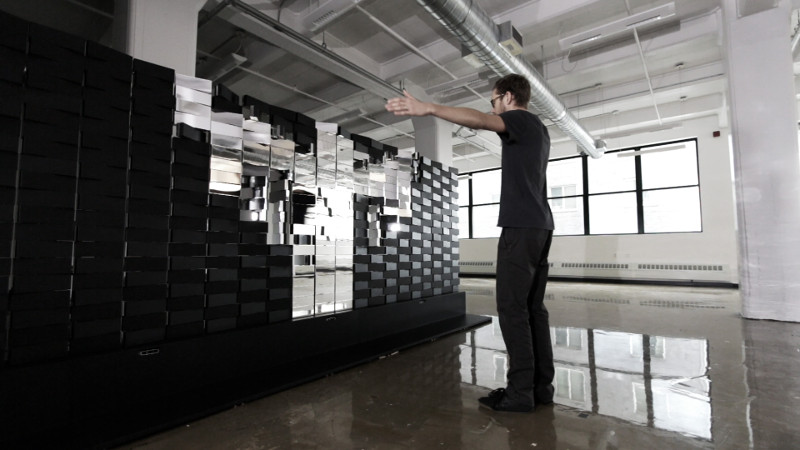There are a great many technologies we use to display information every day. We’re all familiar with plasma displays and LCDs, and then there’s more esoteric hardware like the split flap displays on municipal buses and around train stations. However, Breakfast have been working on something that turns architectural features into a display at the same time. Enter Brixels.
The name is a portmanteau of brick and pixel, indicating that each individual brick can be independently addressed as a visual element. A Brixel installation consists of a series of columns, stacked with Brixel elements. Each individual brick on the column contains a stepper motor which can set the rotational position of the brick. The outer appearance of the individual bricks is highly customizable, as the motor hardware is integrated into the column itself. A Linux machine is used as a primary controller, which passes commands to each column’s controller over RS485, and the column controllers then pass instructions to each individual Brixel.
The Brixels are capable of continuous 360 degree rotation and also contain LEDs for various illumination based effects. The largest current installation is the Brixel Mirror, standing at 18 feet wide, 6 feet high, and containing 540 individually addressable Brixels. These are built with one half covered in a mirror finish, and combined with a depth-sensing camera for all kinds of fun interactive effects.
Brixels show that architectural features don’t have to be static – they can become kinetic, living things that can be aesthetically beautiful and also useful. Breakfast are known for their installations which use modern electronics to push the limits in their artistic installations. Their work on high-speed flip dot displays is particularly impressive. Video after the break.
[Thanks to Sheldon for the tip!]















And how much noise does it make?
That was my first thought, I hoped video had actual audio.
Also Individually Addressable Bricks is a thing now
Pretty much zero. We use Trinamic’s StealthChop stepper drivers, so the only noise you hear is the gears, which is pretty much nothing unless you run it very fast. Even then it’s a fairly satisfying subtle whir.
What happens when you touch it when it is operating? Not something you would want to put in a child care facility even if it was inside a hospital.
The current we’re running to each motor is very low, so if you touch them they simply stall and sit there until you let go. The system detects the stall, rehomes the brick, then it falls back in line wherever it’s supposed to be. It’s actually pretty slick to watch.
Very neat! Was a bit worried there. What did it cost to produce?
how the synchronization is done for all this motors ? The video left me biting nails.
i want a small (and quiet?) version of this, to fit in a picture frame in my room. Maybe one day I’ll build one – doubt it tho, I’m pretty useless in actually making things. I’ve been working on a Kindle weather display for around 4 years now :D
[standing on chair clapping and grinning and shaking my head]
Just stunning!! I would love to see this in person.
It reminds me a lot of Daniel Rozin’s mechanical mirrors.
I’m also curious about the sound it makes since that was one of the best “features” of Rozin’s original Wooden Mirror, and something he worked hard to mitigate before realizing that the audio effect enhanced the visual effect.
Thanks! See comment above per the noise. It’s actually almost entirely silent.
That’s awesome!!! It’s even more awesome when he showed that it’s also interactive.
This is awesome!!! It’s even more awesome that it’s interactive. I’d love to see this in person.
Well I don’t know what practical purpose it serves but I have to admit it’s cooler than polar bear s_it!
We’ll find out if a pixel can be thrown through a window.
Why RS485/RS422 and not something like Profibus or Ethernet? It clearly works, just curious what the limitations might be.
This is like a somewhat bigger version of Daniel Rozin’s wood mirror from 1999. I always loved that project. The sound of it as you moved in front of it was really great. https://www.designboom.com/technology/the-wooden-mirror-by-daniel-rozin/
It is like a dmd chip in slow motion
Tars set humour settings 75.
The installation is cool, the puffery about how an architectural detail can be cool is interesting, but I’m not sure I understand how those two things intersect in this project. Doing something like this is antagonistic to the functions you commonly use bricks for, such as supporting things or blocking weather effects.